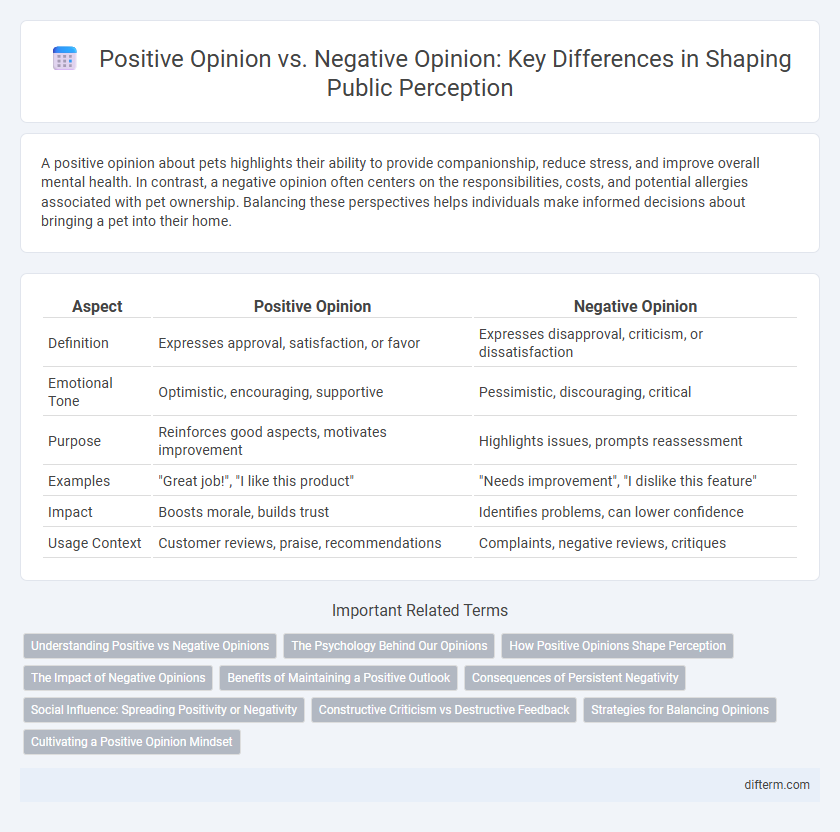A positive opinion about pets highlights their ability to provide companionship, reduce stress, and improve overall mental health. In contrast, a negative opinion often centers on the responsibilities, costs, and potential allergies associated with pet ownership. Balancing these perspectives helps individuals make informed decisions about bringing a pet into their home.
Table of Comparison
| Aspect | Positive Opinion | Negative Opinion |
|---|---|---|
| Definition | Expresses approval, satisfaction, or favor | Expresses disapproval, criticism, or dissatisfaction |
| Emotional Tone | Optimistic, encouraging, supportive | Pessimistic, discouraging, critical |
| Purpose | Reinforces good aspects, motivates improvement | Highlights issues, prompts reassessment |
| Examples | "Great job!", "I like this product" | "Needs improvement", "I dislike this feature" |
| Impact | Boosts morale, builds trust | Identifies problems, can lower confidence |
| Usage Context | Customer reviews, praise, recommendations | Complaints, negative reviews, critiques |
Understanding Positive vs Negative Opinions
Positive opinions highlight benefits, strengths, and favorable experiences, fostering optimism and motivation in decision-making processes. Negative opinions emphasize drawbacks, risks, and unsatisfactory outcomes, encouraging critical analysis and problem-solving approaches. Understanding positive versus negative opinions enables balanced perspectives, improved communication, and informed judgments in diverse contexts such as product reviews, social interactions, and professional feedback.
The Psychology Behind Our Opinions
The psychology behind our opinions reveals that positive opinions often stem from cognitive biases like the halo effect, where favorable impressions influence overall judgment, while negative opinions are frequently shaped by negativity bias, which makes negative information more salient and memorable. Emotional experiences and personal values play crucial roles in forming both positive and negative attitudes, impacting how individuals interpret information and make decisions. Understanding these psychological mechanisms helps explain why opinions can be deeply entrenched and resistant to change, highlighting the complex interplay between cognition and emotion.
How Positive Opinions Shape Perception
Positive opinions significantly influence perception by fostering trust, enhancing reputation, and encouraging openness to new ideas. They create a cognitive bias that highlights strengths and opportunities, which can motivate individuals and organizations to pursue growth and innovation. This optimistic outlook often leads to more collaborative environments and improved interpersonal relationships.
The Impact of Negative Opinions
Negative opinions can significantly influence public perception by shaping attitudes and behavior, often leading to decreased trust and reduced engagement with a brand or individual. The pervasive spread of negative feedback on social media platforms amplifies its impact, creating lasting reputational damage and potential financial loss. Addressing and mitigating negative opinions swiftly is crucial for maintaining credibility and fostering positive relationships.
Benefits of Maintaining a Positive Outlook
Maintaining a positive outlook enhances mental resilience by reducing stress and improving emotional well-being, leading to better physical health outcomes such as lower blood pressure and a stronger immune system. Positive opinions foster constructive relationships and effective communication, which contribute to personal and professional success. Cultivating optimism encourages proactive problem-solving and increased motivation, ultimately boosting overall life satisfaction.
Consequences of Persistent Negativity
Persistent negativity erodes mental health, increasing risks of anxiety and depression by reinforcing negative thought patterns. It damages relationships through constant criticism and distrust, leading to social isolation and diminished support networks. Prolonged exposure to negative opinions also hinders professional growth by reducing motivation and impairing decision-making abilities.
Social Influence: Spreading Positivity or Negativity
Positive opinions amplify social influence by encouraging constructive behaviors and fostering community trust, which enhances collective well-being. Negative opinions often propagate fear or distrust, undermining social cohesion and increasing polarization. The balance between spreading positivity or negativity significantly impacts societal dynamics and individual mental health.
Constructive Criticism vs Destructive Feedback
Constructive criticism fosters growth and improvement by offering specific, actionable suggestions that encourage learning and development. Destructive feedback, on the other hand, often focuses on personal faults or vague negativity, leading to demotivation and decreased performance. Emphasizing constructive criticism cultivates a positive environment where challenges are seen as opportunities for progress rather than failures.
Strategies for Balancing Opinions
Balancing opinions requires actively listening to diverse viewpoints and validating the emotions behind them to foster mutual understanding. Employing techniques such as reframing negative feedback into constructive dialogue promotes collaboration and problem-solving. Encouraging open communication and empathy helps create an environment where positive and negative opinions coexist productively.
Cultivating a Positive Opinion Mindset
Cultivating a positive opinion mindset enhances mental well-being by encouraging openness and constructive feedback processing. Focusing on strengths and opportunities promotes resilience and improves interpersonal relationships through empathy and understanding. Embracing positivity fosters growth, reduces stress, and creates an environment conducive to collaboration and innovation.
Positive opinion vs Negative opinion Infographic

 difterm.com
difterm.com